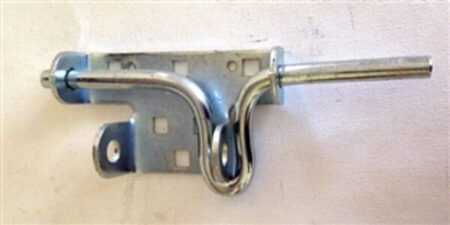Is Your Garage Door Truly Locked?

I clearly remember the day a friend visited my new home. As we were leaving, he noticed I didn’t lock the door leading from the garage into the house and asked why. I told him, “The garage door is locked,” to which he replied, “You’re just one broken garage window away from a break-in.”
That single comment completely changed how I thought about my home’s security. It was a wake-up call that my garage was a major weak spot in my home’s protection.
I quickly realized I had more work to do to properly secure my garage. Locking the main overhead door was only the first step in a much larger security plan.
So, how do garage doors lock? If you have a manual door, you usually need to add a lock yourself. Most automatic doors use the opener’s motor to keep them shut, but that isn’t always enough. For real security, you’ll want to add a manual lock or get a new opener that has its own automatic deadbolt.
How Do Automatic Garage Doors Stay Closed?

If you have a remote control for your garage door, you have an automatic opener. This system gives you a basic level of security, but it may not be a true “lock” in the way you might think.
Most standard automatic garage door openers don’t use a physical deadbolt like the one on your front door. Instead, they depend on the force of the motor and drive system to hold the door firmly closed.
This mechanism, sometimes called a “PosiLock” or trolley lock, provides resistance against someone trying to lift the door by hand from the outside.
While this is good at stopping a casual attempt, it is far from a perfect security system. A determined intruder can often get past this basic level of protection without much trouble.
For Maximum Security: Openers with Automatic Deadbolts
For homeowners who want the best in automated security, there’s a clear upgrade. Certain premium smart garage door openers provide a much stronger solution.
Models such as select wall-mount openers from Liftmaster feature an integrated automatic deadbolt lock. This feature is a huge improvement for garage security.
This advanced device shoots a physical, solid steel bolt into the door’s track every single time it closes. This action physically bars the door from moving.
Compared to the simple resistance of a motor, this automatic deadbolt offers much better security, making your garage door a truly tough barrier.
What Is the ‘Fishing’ Method Burglars Use?

The most common weakness in standard automatic garage door security is a simple break-in method known as “fishing.” Thieves can take advantage of even a small gap at the top of the garage door.
As confirmed by security experts, an intruder can push a wire hook through this opening. With a little wiggling, they can hook the emergency release cord that hangs from the opener.
Once the cord is hooked, a simple pull is all it takes to disengage the opener from the door. This allows the thief to lift the garage door manually and get into your home.
This technique requires no special tools and bypasses the opener’s motor lock completely, showing a critical weak spot in millions of garages.
How Can I Stop a ‘Fishing’ Break-in?
Luckily, there is a very easy and popular fix to defeat the “fishing” method. A single, heavy-duty zip tie can be your first line of defense.
Simply secure the manual release lever to the opener’s trolley assembly with a zip tie. This prevents the lever from being pulled down by a hook from the outside.
This makes it impossible to pull the release cord without first cutting the tie, which can’t be done from outside the garage.
For a slightly cleaner look, you can also buy a commercial garage door shield. This plastic or metal shield covers the release lever entirely, blocking access from a wire hook.
This one simple act greatly increases your garage’s security for just a few minutes of your time and almost no cost.
How Can I Add More Security with an Interior Slide Lock?

One of the most effective ways to boost your security is with a manual lock. A garage door inside lock—also known as a garage door security slide-bolt lock—is a rock-solid option.
This lock consists of a sturdy sliding bolt that you install on the inside of your garage. One part attaches to the door itself, and the other attaches to the wall or frame.
When you slide the bolt shut, it runs through the garage door’s track, physically blocking the door from being able to go up.
These locks are highly effective, very inexpensive, and easy for any DIY-capable homeowner to install, making them a great addition for any garage.
What Is a Classic T-Handle Lock?

The keyed T-Handle lock is one of the most common manual locks you’ll see on the outside of garage doors. As the name suggests, the handle on the outside of the door is shaped like a “T.”
On the inside of the door, two long metal rods connect to the T-handle’s central mechanism. When you turn the handle with a key from the outside, these bars slide into slots or holes in the vertical tracks of the garage door.
This action effectively locks the door in place, physically preventing it from being raised. When you unlock the T-handle and turn it, the bars pull back from the tracks, allowing the door to open freely.
This design is a classic for a reason, providing a reliable and visible deterrent to potential intruders.
A Critical Warning: Don’t Mix Manual Locks and Automatic Openers
This is an incredibly important safety warning for any homeowner with an automatic opener. Never engage a manual lock, like a slide bolt or T-handle, if your automatic garage door opener is connected.
Trying to open the door with the motor while it is physically locked can cause severe damage. The force of the opener pulling against a locked door can be catastrophic.
You risk bending or destroying the door panels, twisting the tracks, and burning out the opener’s motor. This can lead to hundreds or even thousands of dollars in repairs.
Always disengage the manual lock before using your remote or the wall button. If you plan to use manual locks for an extended time, you must disconnect the opener from the door using the emergency release cord.
A High-Security Option: The Center Mount Deadbolt Lock

For those looking for a serious upgrade in manual lock security, a center mount 5-pin tumbler deadbolt lock is an excellent choice. It offers a significant step up from standard T-handles.
It’s called a “center mount” because it’s typically installed in the middle of the garage door. This placement ensures that any force applied to the door is spread evenly across the lock.
The “5-pin tumbler” refers to the key mechanism, which uses five pins of varying lengths. This makes the lock much more complex and difficult for a thief to pick compared to simpler designs.
The “deadbolt” is the solid metal bar that secures the door. Known for their strength, deadbolts are a top choice for security. When you turn the key, this bar slides into a slot in the door track, providing a tough locking point.
Is an “Emergency Release Lock” a Good Security Feature?

Let’s be perfectly clear about one specific product: the “garage door emergency opener keyed release disconnect key lock.” This device is a potential security weakness, not an improvement.
An emergency release lock is NOT a security lock. In fact, its entire purpose is to create a way to get in from the outside.
Its only job is to let you disengage the automatic garage door opener during a power failure or if your remote stops working. This lets you open the door manually from the outside.
It works by connecting a simple exterior lock to the emergency release lever with a cable. Turning the key lets you pull the cable, which pulls the release, disconnecting the door from the opener motor.
Why Is an Emergency Release a Security Risk?
The main problem with an emergency release lock is that it creates a direct, physical link from the outside of your garage to the opener’s release mechanism. You are essentially installing a bypass on your own door.
The lock cylinder on these devices is often simple and can be easily defeated by a determined thief with basic lock-picking tools or brute force.
As noted by garage door specialists, these types of locks can create a major security risk if a lower-quality lock is used.
While an emergency release lock might be necessary for homeowners without any other way into their garage, you should always think of it as the opposite of a security feature.
Your Action Plan for a More Secure Garage Door
To sum up, the type of lock on your garage door depends on the door itself. Standard manual doors typically don’t include locks and require you to add one to be secure.
Most automatic garage doors provide basic security through the opener’s motor, but they are open to common break-in methods. For true peace of mind, it’s smart to take a few extra steps.
Your best options for securing your garage door include using a zip tie or a purpose-built shield on the emergency release handle. Another great choice is adding a manual slide bolt lock for when you’re on vacation or away for long periods.
You can also install a high-quality manual T-handle or a center deadbolt lock for robust, key-operated security. Finally, the best solution is to upgrade to a modern garage door opener that has an integrated automatic deadbolt.
For more ideas on how to secure your garage, see this guide on Overhead Door.









